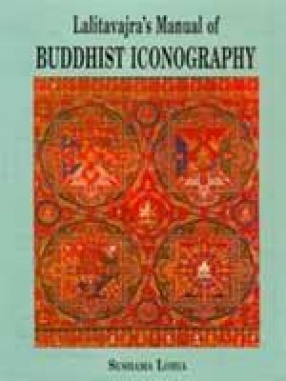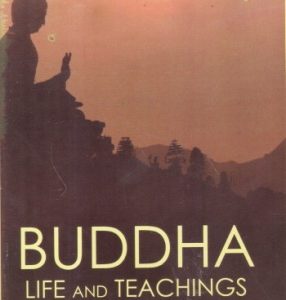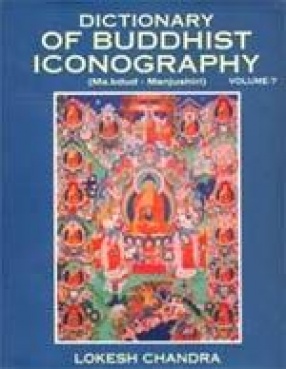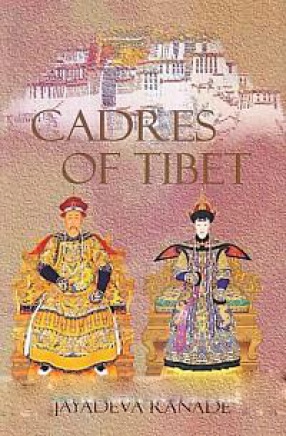Lalitavajra’s manual is a fundamental contribution to the understanding of Buddhist iconography. It is one of the earliest pantheons by the famous Lcan-skya Incarnate Rol.Pahi.rdo.rje or Lalitavajra who was the dominating lamaist figure at the Manchu Court of K’ien-lung (1736-1795 AC). Lalitavajra lived from 1717 to 1786 AC and so this pantheon has to be dated in the eighteenth century. It was xylographed with his preface and illustrates three hundred masters and divinities. It was annotated by the German professor Eugen Pander at the end of the 19th century when the tradition was very much alive. He wrote two books: (1) Das lamaische Pantheon, Berliner Zeitschrift fur Ethnologie, 1989, Heft 2; (2) Das pantheon des Tschangtscha Hutuktu, ein Beitrag zur Ikonographie des Lamaismus, revised by Albert Grunwedel, Veroffentlichungen aus dem konigl. Museum fur Volkerkunde I.2/3, Berlin 1890. The first book is a general survey and the second illustrates some but describes all the three hundred icons. Dr. Sushama Lohia has translated both from German into English to make them accessible to the English-reading world of scholarship. Inspite of the lapse of over a hundred years they are still relevant for their Chinese names as well as by their being the only descriptions written in Beijing when the tradition was flourishing. Albert Grunwedel himself re-drew the three hundred icons and published them in the Bibliotheca Buddhica in 1903: Sbornik izobrazenii 300 burkhanov, St. Petersburg. The original xylograph was published by Lokesh Chandra in his Buddhist Iconography (Kyoto 1986, and New Delhi 1991, pages 685-784), alongwith the mantras of every icon. The mantras are important for ritual, meditatioin and also for the Sanskrit names embedded in them. The three hundred icons are painted on three thanka scrolls, preserved at the American Museum of Natural History, New York. This work reproduces the original xylograph along with the mantras, the sketches in Pander and in Grunwedel, with the text on opposite pages. The illustrations and their descriptions confront each other, and thus facilitate comprehension. It adds a new source to the study of Buddhist iconography. The descriptions of the images, their classification, mantras for meditation, excursus on iconic attributes, the Tibetan, Sanskrit and Chinese names of every deity, and a comprehensive index will inspire new studies as well as help us to correct well known sources, such as Alice Getty’s Gods of Northern Buddhism.
Lalitavajra’s Manual of Buddhist Iconography
$43.20
$48.00
In stock
Free & Quick Delivery Worldwide
All orders amounting to US$ 50 or more qualify for Free Delivery Worldwide. For orders less than US$ 50, we offer Standard Delivery at $14 per book.
ABOUT THE AUTHOR Sushama Lohia
Dr. Sushama Lohia, daughter of the eminent Indologist and Buddhologist Prof. Raghu Vira, did her M.A. from the Delhi University in 1958. She edited the Samantabhadra-carya-pranidhana-raja in Sanskrit, Tibetan, and three Chinese versions, with a Sanskrit-Tibetan index, in 1962. She is married to Drs. Rakesh Lohia an expert in ceramic technology. She studied Tibetan and Mongolian Buddhism at the Seminar for the Languages and Cultures of Central Asia at the Bonn University, under the famous Mongolist Prof. Walther Heissig for five years, and completed her Ph.D. at Bonn in 1964. She translated and annotated the Ghucin qoyar modun kumun-u uliger in its Mongol version of 1746 (1686), with a long introduction (publ. Otto Harrassowitz, Wiesbaden). Now she lives in Irvine, California.
reviews
0 in total
Review by Anonymous
Be the first to review “Lalitavajra’s Manual of Buddhist Iconography” Cancel reply
You must be logged in to post a review.
Bibliographic information
Title
Lalitavajra’s Manual of Buddhist Iconography
Author
Edition
1st ed.
Publisher
ISBN
8185689970
Length
v+283p., Figures; Index, 29cm.
Subjects
similar bookssee more
Cadres of Tibet
$54.90
$61.00





There are no reviews yet.